For a business to succeed, it needs to generate more leads to turn into customers. Hence, the more leads you can capture, the more revenue you will collect. A sales funnel is an excellent tool for collecting leads and converting them into customers.
To build a sales funnel from scratch, businesses first need to understand their target audience and their buying behaviors based on the different funnel stages. Afterward, they can focus on creating landing pages, driving traffic, and engaging with their audience.
This post will take you through a step-by-step process for building a sales funnel from scratch. Let’s get started.
Steps for Building a High-converting Sales Funnel from Scratch
Although many people rely on funnel building agencies, it is possible to build a sales funnel from the ground up.
Once you know the process, you can easily create a funnel with software like ClickFunnels or HighLevel, or implement the strategy with your existing business tools.
You can check out both these tools through their FREE trial by visiting:
Here are the steps you need to follow:
Step 1: Define and Understand Your Target Audience
The first step toward building a sales funnel is defining your target audience. Identifying your target will help you create a sales funnel with a specific purpose.
Ultimately, you will avoid the frustrations of trying to sell to everyone in the world. A small, well-defined audience is much easier to market to.
Although your product may be useful to people of various ages, locations, and gender, it is better to pick a few specific groups to target.
As a result, you can share messages and solve problems that are important to that group. Additionally, you can build strong and long-lasting relationships.
You can understand your target audience through surveys, feedback from current customers, social media, and web analytics.
In addition to identifying your targets, study how they interact with your website and content.
Thus, their behavior will guide you on what stages you need to create for your funnel.
Here are steps to help identify your target audience:
- Identify your customer’s core desire when buying your product.
- List several submarkets relevant to your customer’s desire. For instance, if the core desire is health, then submarkets include healthy eating, physical fitness, weight loss, etc.
- Choose a submarket and select a niche. For instance, in the weight loss submarket, niches include home workouts, weight loss supplements, and low carb diets.
- Research your customers’ pain points, challenges, questions, and desired results. Quora and Answer the Public are excellent sites for finding commonly-asked questions in your niche.
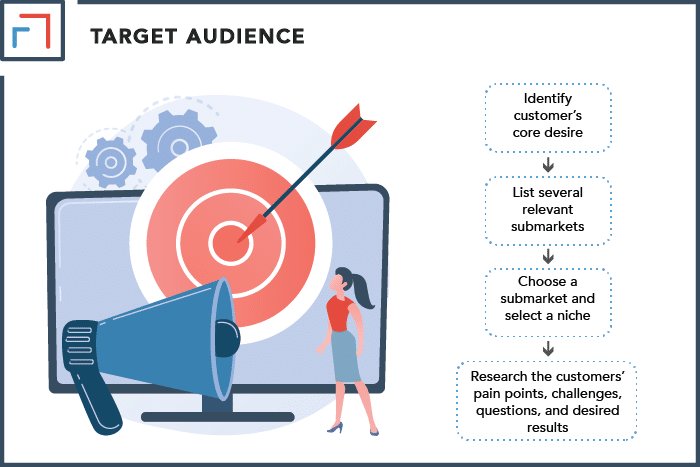
Step 2: Visualize Your Ideal Customer Journey from Lead to Customer
Most customers have to go through a series of steps in the sales funnel before they convert.
Thus, the primary goal of a sales funnel is to ensure leads move smoothly through the buying process.
Once you’ve defined your target audience, you can now visualize their movement through the funnel.
Although you will find tons of sales funnels on the web, the premade ones can only take you so far.
Every business is different so it’s necessary to tailor your funnel for your business. However, every business needs a sales funnel.
To create the best funnel, identify your customers’ steps from the beginning to the end.
When mapping out your customer journey, consider:
- Your current customer journey.
- The action you want your audience to take at the end.
- Your previous transactions and analytics. (For instance, what made some customers stay and others move away).
With your end goal in mind, you can now lay out your sales funnel framework. This way, you will stay on track as you continue to adjust your sales funnel.
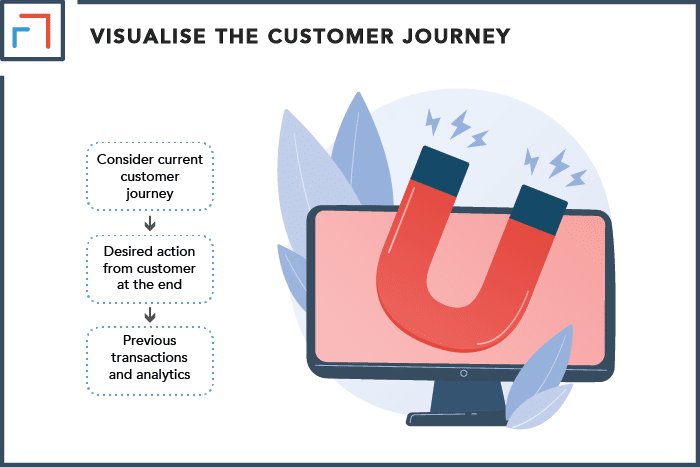
Step 3. Understand Customer Buying Processes
As you narrow down your niche and audience, understanding how your targets shop is crucial.
This will help you move your leads through the funnel smoothly since you understand what they need at each stage of the process.
At the same time, understanding the buyers’ behavior will help you set goals for each segment of the funnel.
In addition, the different funnel stages can influence customer behavior.
For instance, leads at the top of the funnel may not show as much interest in your business compared to those in the middle.
That said, the top, middle, and bottom parts of the funnel each have distinct goals. Hence, the need to build different funnels and marketing strategies.
You can check out my marketing funnel strategy examples for inspiration.
Here are various stages of the customer buying process:
Pain Point/ Need Recognition (Top of the Funnel)
At the top of your funnel, leads are aware of their problem, but they may not be seeking a solution yet.
For instance, if a struggling accountant is unaware of an existing accounting solution, they are unlikely to look for it.
However, if they see an advertisement for accounting software, they are likely to show interest and look for more information.
Therefore, attracting leads at this stage consists of outbound marketing and advertising.
Here are some content ideas you can use when building your funnel at this stage:
- Social media posts
- TV and radio ads
- Blog posts
- Influencer marketing
Information Search (Middle of the Funnel)
In the middle of the funnel, customers start actively looking for solutions to their problems.
You will need to create content that resonates with their pain points in this stage. To build trust, address the pain points authoritatively.
Some of the strategies to leverage at this point include:
- SEO
- Social media
- Content marketing (such as YouTube videos)
- Case studies
- Free downloads
Since prospects have decided to look for solutions to their problems, they may explore alternative solutions.
Consequently, when creating a funnel in this stage, focus on educating your audience on how your product will solve their problems.
Purchasing Stage (Bottom of the Funnel)
Leads in this stage are in the action stage of the funnel and are most likely to make a purchase.
So, here you need to focus on convincing your prospects to buy your product or subscribe to your service.
Here are some marketing strategies you can use:
- A money-back guarantee (30 days is common)
- Offer free trials
- Add customer reviews
- Include a support chat function to answer questions
- Minimize the number of form fields
- Simplify the checkout process
Ultimately, if you nail the search intent in the information search above, you won’t have to struggle in this stage.
This is because your leads are ready to purchase as long as they understand how your product solves their problem.
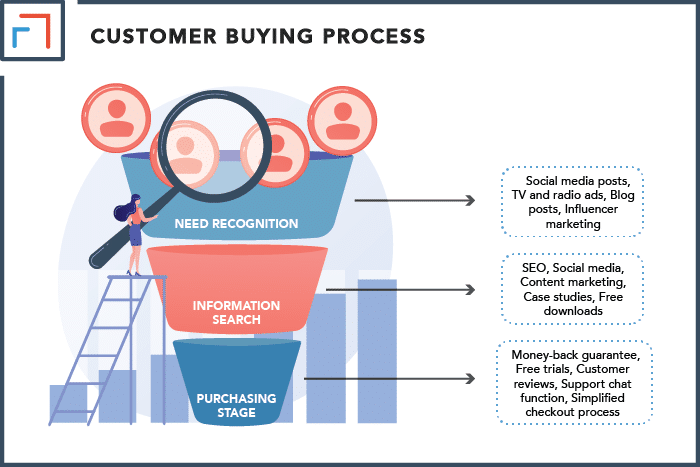
Step 4: Capture Your Leads
Capturing leads entails a great deal of marketing. Therefore, you need to capture the attention of your targets then channel them into your funnel.
To do so, you need to create appealing content and broadcast it to your audience.
There are many ways you can create content, such as:
- Blogging about the products you want to promote. You could write reviews or offer tutorials and guides about product usage. Or, you can write educational content that solves problems.
- Create YouTube videos revolving around a particular niche.
- If you do not mind spending, running paid ads is a quick way to capture leads. Examples of ads services include Google Ads, Facebook Ads, and Bing Ads.
My detailed guide on email marketing content ideas will help you find the right voice and content.
Whichever route you take, the key is to warm up the leads. You want to earn their trust to help them enter the funnel.
Step 5: Build a Stellar Landing page
Once you have analyzed your target audience, visualized your funnel, and understood their behavior, it is time to create your landing page.
The landing page is where your visitors are directed after reading your blog, watching a video on your channel, or viewing your advertisement.
Your landing page is your chance to make a good first impression. Similarly, it is your opportunity to create brand awareness.
Due to the complex and changing business environment customers are becoming more and more demanding and less loyal to their current brands.
How you design this page determines whether your visitors will stay or leave. Therefore, you want to ensure they have a good experience.
Here is how you can create a good landing page and prevent your first impression from being the last:
- Keep the design clean and straightforward.
- Feed the curiosity of your visitors. This causes them to stay and discover more.
- Offer benefits that resonate with your audience’s pain points.
- Choose attention-grabbing headline fonts and sizes carefully.
- Use images and graphics that complement the headline’s message.
- Keep your page clear and to the point. A busy page is a complete turnoff; no customer wants their head to spin from too much info. Less is more.
- Craft a powerful headline and add a bold call to action to guide your visitors to their next course of action. Failing to add a CTA will cause many leads to drop off.
- Make an offer such as free downloads, ebooks, and guides in exchange for contact information. This data will help you to create targeted email campaigns in the future.
You can also check out these landing page examples built using ClickFunnels that are converting like crazy!
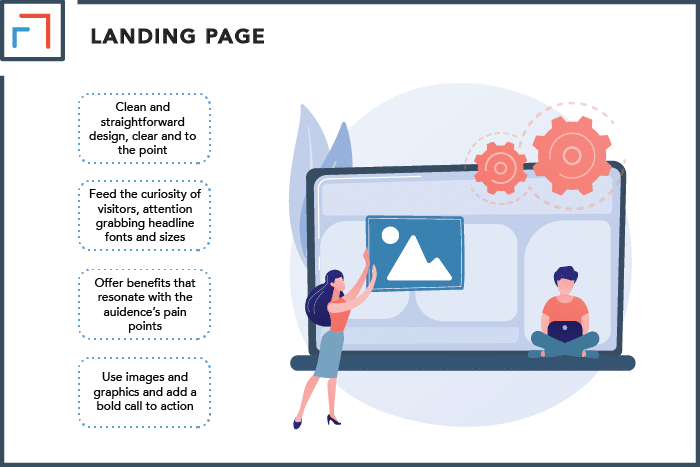
Step 6: Generate Traffic for Your Landing Page
For your landing page to be effective, you need to get people to visit it. The more people visit your landing page, the more leads you will generate.
Although there are several ways to generate traffic, here are a few quick ones:
- Optimize your landing page for search engines so you can rank higher. Ranking higher is crucial since people tend to open the top results and ignore the bottom ones. To optimize your pages, check the loading speeds, keywords, and backlinks.
- Use social media to engage communities, share your products, and interact with others from your niche.
- Create paid ads as a quick way to generate traffic.
Step 7: Create an Email Drip Campaign
By now, you will have collected email addresses from the landing page offers we discussed earlier. These addresses will prove to be a valuable asset.
They will help you communicate with your leads as long as they remain subscribed to your email list.
Share a series of useful and timely emails with your leads. For instance, if a customer abandons a cart, you can send them a reminder email.
The emails should always be valuable and informative. You will need to send them emails regularly but do not go overboard.
If you send daily emails, it may overwhelm your leads. They may even get annoyed with you and unsubscribe.
Generally, 2 to 3 emails a week should suffice. Similarly, limit the number of sales emails you send because these can be a major turnoff.
Instead, portray your product or service as a solution to their problems. Again, consistent communication helps push leads further down the funnel.
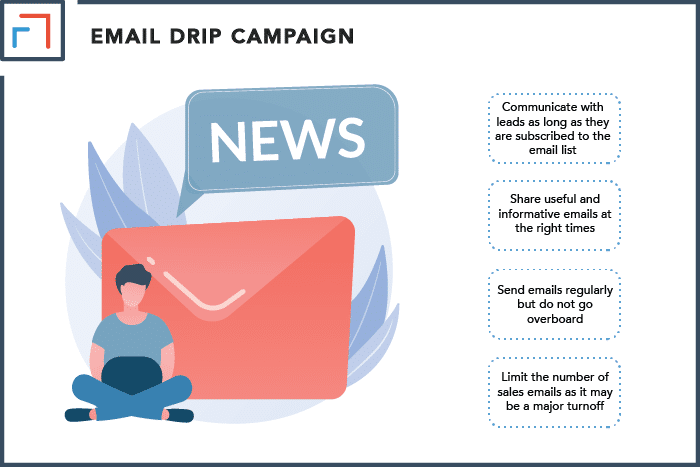
Step 8: Create a Sales Funnel Upsell and Downsell to Boost Sales
An upsell is a product/ service upgrade that makes your customers buy more. For instance, they might buy an extra item in addition to their earlier selection.
Upsells should be relevant and beneficial to the prospect. On the other hand, a down-sell is a downgrade targeting those who didn’t buy or upsell.
Although down-sells are cheaper, they aren’t entirely bad because they can help you retain budget-conscious customers.
If they are happy, they will keep coming back.
Step 9: Stay in Touch With Your Existing Customers
Do not let your customers’ contact with your brand end upon purchase.
You can build better relations with them by creating an exclusive email campaign for them.
You can also stay in touch via social media, surveys, loyalty programs, and by suggesting related helpful products/services.
Additionally, communicate your appreciation for them whenever they buy or sign up for your offer. If they feel valued, they are more likely to return.
Consequently, the happier you make them, the more they are to return to you.
Step 10: Improve Your Sales Funnel
At this point, you should have a complete funnel. Now it is time to make it live and optimize your efforts to generate more leads and conversions.
However, it is rare to get it right the first time.
In addition, as your business grows and you get to understand your leads better, your funnel will need some tweaks and changes.
Therefore, there is plenty of room for improvement. You can make your funnel work better by checking if each step is working then optimizing it as needed.
Even though it sounds like a lot of work, you will reap big rewards once you get it right.
Here are some things to check:
- Number of landing page visitors
- Source of incoming traffic
- Email open rates
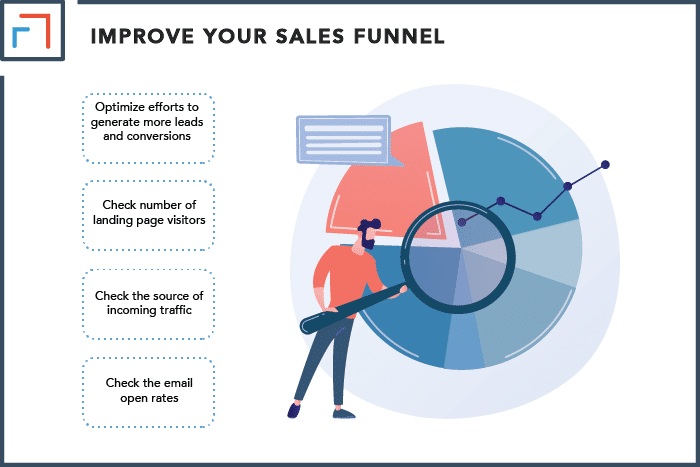
Take it One Step at a Time…
Learning to create a sales funnel is the first step toward increasing your conversions.
Although you may not complete all 10 steps in a day, taking the first step matters.
By investing time to learn how to build a sales funnel from scratch, you position your business for success amid stiff competition.
To build a high-conversion funnel, you always need to adjust and improve your strategy.
Sometimes, even a small action like changing your background color can boost your conversion rate!
Now that you understand how to build a sales funnel, you can create your own with the steps above.
